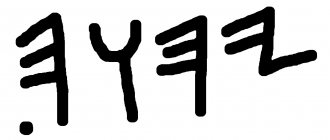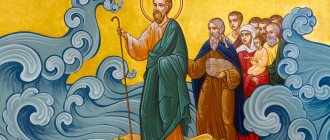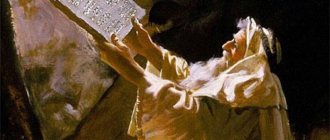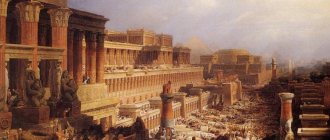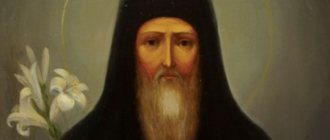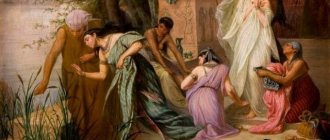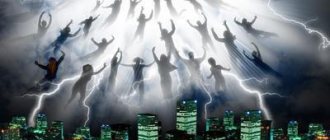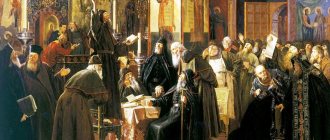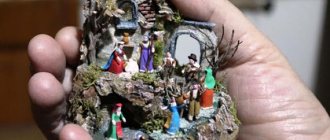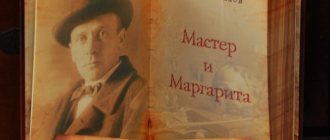Bible
It is believed that the burning bush in which the angel of the Lord appeared before Moses was a blackberry bush: “... the bush burns with fire, but the bush is not consumed” (Exodus 3:2).
A thorn bush near Mount Horeb, in which God appeared to Moses, calling him to deliver the people of Israel from Egyptian slavery. Moses saw that this bush was burning and was not consumed (Ex. III, 2).
The burning but unburnt bush represents the Fiery Angel who appeared before Moses (Ex. 3:1-10).
While tending his father-in-law's flocks, Moses came to Mount Horeb, where he saw a vision of a bush that was burning, but was not consumed. From the bush, the Lord himself called to Moses, telling him that he must free the people of Israel from their Egyptian oppressors and lead them to Canaan, “where milk and honey flow.”
Moses is depicted kneeling in front of a bush or taking off his shoes, as Muslims do on the holy land. Sometimes his paternity turns into a snake - a sign of divine presence.
The calling of the prophet Moses. Part 1. Burning Bush
Archpriest Oleg Stenyaev talks about why Moses tended his flocks in... the desert, how the holy fathers explained the phenomenon of the Burning Bush, about the “sacred curiosity” of Moses and what “shoes” every Christian should take off.
Moses sees the Burning Bush. Mosaic fragment. VI century Basilica of San Vitale, Ravenna
What can be called the spiritual preparation of Moses is described in both the 2nd and 3rd chapters of the Book of Exodus. These chapters tell how the Lord shaped the character of Moses, developing and revealing in him precisely the feeling of a heightened desire for justice: first Moses tries to protect a fellow Jew and kills the Egyptian oppressor (cf. Ex. 2: 11-12), then Moses already separates his brothers (cf. Ex. 2: 13–14), and after that Moses stands up for the daughters of the Midian priest, who were driven away from the well (cf. Exod. 2: 16–17).
Shepherd
But, from the point of view of the interpretation of the holy fathers, Moses acquired the main qualities necessary for a spiritual leader when he spent decades tending sheep for his father-in-law, the priest of Midian.
“Moses was tending the sheep of Jethro his father-in-law, the priest of Midian. One day he led his flock far into the desert and came to the mountain of God, Horeb” (Ex. 3: 1 ).
It would be more accurate to translate that Moses tends his father-in-law's sheep, leading them far into the desert. And really, how can you herd sheep in the desert? There may be two reasons for this.
The first reason may be that Moses is sensitive to other people's property and does not want to cause any damage to other people's possessions, other people's meadows and plots of land for grazing sheep. Careful in detail, he could actually be exalted by God for his strict desire to fulfill all the subtleties of God's Law.
The second reason for Moses’ departure from this world with his flock is the awareness, or, rather, even the intuitive foreknowledge of God’s great mission that awaits him: he must lead God’s people among aggressive tribes and peoples and for 40 years lead them through the desert, “as sheep among wolves" (cf. Matthew 10:16).
Moses tends the flocks of Jethro and the Burning Bush. Mosaic. VI century Basilica of San Vitale, Ravenna
The very relationship of the Creator with His creations is considered in the Bible as the relationship of a shepherd-shepherd with his sheep: “As a shepherd inspects his flock on the day when he is among his scattered flock, so I will look over My sheep and free them from all the places to which they were scattered on a cloudy and gloomy day. And I will bring them out from among the nations, and gather them from the countries, and bring them into their own land, and I will feed them on the mountains of Israel, and by the streams, and in all the inhabited places of the land” (Ezek. 34: 12-13).
There is a legend about how Moses once lost a little sheep, searched for a long time and finally found it near a stormy river. The lamb was thirsty, but did not dare to approach such a furiously noisy stream. In emotion, Moses exclaimed: “Poor lamb! I didn’t think that you were just thirsty, so I ran to the water! You are tired, and now I will help you.” Having watered the lamb, Moses carried it on his own shoulders to the flock. And then the Lord God said: “You have compassion for the flock that belonged to an ordinary mortal man of flesh and blood! From now on you will shepherd Israel, My flock.”
The expression “and came to the mountain of God, Horeb”, on the one hand, seems to anticipate the glorious events associated with this place,1 on the other hand, it may indicate that miraculous events began immediately as soon as Moses and the herd “came to the mountain” .
There is such a legend: when Moses passed by Mount Horeb, he noticed that the birds were afraid to approach the mountain and were circling in the distance. When Moses headed towards the mountain, it seemed to him that the mountain “in response” itself began to move in his direction. As soon as Moses retreated, the mountain also returned to its original place. And only when Moses approached and stepped on the foot of Mount Horeb, it settled and froze in one place. Those of you who have somehow visited the desert will not consider such a legend unreliable: the well-known mirages of the great deserts actually either bring extremely distant objects or landscapes closer or move them away.
“A step away from love for this world”
And then we read:
“And the Angel of the Lord appeared to him in a flame of fire from the midst of a thorn bush. And he saw that the thorn bush was burning with fire, but the bush was not consumed” ( Ex. 3:2 ).
The expression from the Synodal translation: “in the flame of fire” seems too vague, like the phrase “butter.” It would be more correct to translate: from the core of the fire. And the “thorn bush,” on the one hand, indicates the material that is most susceptible to fire, on the other hand, it indicates the most inconspicuous tree of the local flora, inconvenient and clumsy.
This is exactly how the children of God are perceived in this world. It is said: “Look, brethren, who you are who are called: not many of you are wise according to the flesh, not many of you are strong, not many of you are noble; but God has chosen the foolish things of the world to shame the wise, and God has chosen the weak things of the world to shame the strong things; God chose the base things of the world and the things that are despised, and the things that are not, to bring to nothing the things that are” (1 Cor. 1:26-28).
Clement of Alexandria Christocentrically perceived the vision of the Burning Bush, covered with thorns:
Just as the Logos appeared in a bush of thorns, so later, in a crown of thorns, he showed: these are works of the same Divine omnipotence
“When the omnipotent Lord of the universe undertook the publication of the Law through the Logos and wanted to demonstrate His power to Moses, a Divine vision appeared to him in the form of light in a burning thorn bush. The thorn bush is a prickly plant; and when the Logos has finished legislation and life among men, in a mysterious way He is again crowned with thorns. Returning to where he came from, He finished the work of His ancient parish. Just as before the Logos appeared in a bush of thorns, so later, captured, He showed in a crown of thorns that all of this is the work of one and the same Divine omnipotence, that He is the one Son of the one Father, the beginning and the end of world time.”2
Liturgical theology contemplates in the Burning Bush the Most Holy Virgin Mary Herself, Who unburntly received into Herself the One about Whom it is said: “Oh that You would rend the heavens and come down! The mountains would melt at Your presence as with melting fire...” (Isa. 64: 1-2).
The Monk John of Damascus interpreted this image exactly this way:
“The bush was the image of the Mother of God, and God said to Moses, who was about to approach her: “Take off your sandals from your feet...” So, if the land is holy, on which the image of the Mother of God was revealed to Moses, then how many times larger is this image? For he is not only a saint, but, I dare say, even a saint among saints.”3
In any prophetic phenomenon, both the word of God itself and the images with which it is accompanied are equivalent. Moreover, sometimes the word of God is the revelation of a vision, and sometimes vice versa: prophetic visions in reality are more clear, vivid and better remembered than dream visions or prophetic visions in a state of fainting (cf. Numbers 24: 4). Sometimes a miraculous (unusual) phenomenon can prepare a person for the prophetic dialogue itself, as if gradually accustoming him, introducing him into it.
“Moses said: I will go and see this great phenomenon, why the bush is not burned” ( Ex. 3: 3 ).
“When Moses saw that the bush was burning and not being burned, he marveled at the vision and said: “I’ll go and look at this phenomenon.” But it’s not that he himself meant that he would go through some space, cross mountains or overcome rocks and valleys. The appearance was right there, before his face and before his eyes. But he said: “I will go,” to show that the heavenly phenomenon reminded him that he must enter into a higher life and move from what he lived among to something better.”4
The words translated here as “I’ll go and look” are more correctly translated as “I’ll probably turn around and look.”
This is exactly how Saint Gregory the Great, Pope of Rome, understands them, he writes:
“Therefore Moses, who sought the glory of the highest contemplation, said: “I will go and see the vision.” If he had not taken a step in his heart away from love for this world, he would never have been able to comprehend the higher things.”5
“I’ll go” - from Latin: “I’ll turn”! And “to take a step aside” means to turn away from the previous path.
Burning bush in the monastery of St. Catherine
A person who is able to pay attention to an unusual phenomenon and not pass it by is a person with heightened inner intuition. It is precisely such people, capable of leaving their “herds” of human problems and thinking about the miraculous, who are called “mystics,” for whom the supermundane is much more real and much more important than the everyday and everyday.
In the Orthodox tradition, mystical theology is revealed to people of the contemplative type, less active, perhaps, but more contemplative6.
Here another reason is revealed to us why Moses “led ... the flock far into the wilderness”: he could seek solitude from the noisy pagans of Midian.
After all, the Son of God Himself, at the crucial moments of His earthly ministry, sought solitude and silence, without which it is impossible for true humanity to hear the true Divinity. It is said: “Jesus departed from there by boat to a deserted place alone” (Matthew 14:13). And again: “Jesus, having learned that they wanted to come and accidentally take him and make him king, again withdrew to the mountain alone” (John 6:15).
So is Moses! And even more so, each of us, deafened by the screams and squeals of the so-called “civilized” world, needs to reflect on silence and unfussy loneliness. At least for a while, for a year or a month, even if just for one day or one hour...
The pace of the modern world, offensive information flows absorb consciousness and return it to us distorted, torn and half-decayed. We miss thoughtful advice and quiet instructions that can only be heard with the heart. The world of politics, and even religion, shouts, agitates, is engaged in its own marketing, but we need to stop and stop the thoughts that are not ours, other people’s, rushing through our consciousness, to hear the voice of antiquity, a voice that is not hysterical, but judiciously calm, with the quiet joy of personal communication with the past . It is said: “Thus says the Lord: Stand still in your ways and consider, and ask about the ancient ways, where is the good way, and walk in it, and you will find rest for your souls” (Jer. 6:16).
On the other hand, the question: “a great phenomenon, why the bush does not burn up” is an ecclesiological, that is, church, question. It is rationally impossible to explain the existence of the people of God in its two historical dimensions: Old Testament and New Testament times.
The sacred history of the Old Testament Church shows us how many times the existence of the people of God approached the tragic point of the “final solution to the Jewish question”: this happened in Egypt, Babylon, Persia, Greece and Rome! But the sacred history of the New Testament Church, which continues to this day, has revealed tragic pages of attempts to “completely resolve the church issue” - both in ancient times and during the Islamic wars.
In essence, the USSR experienced persecution of the Church for most of the 20th century. These are, in particular, the “godless five-year plans” and Nikita Khrushchev’s promise to show the last Russian priest on TV.
But the worst persecution is yet to come. And in the prophet Daniel we find the words: “...and a difficult time will come, such as has not happened since people existed until this time; But at that time all of your people who are found written in the book will be saved” (Dan. 12:1).
The guarantee that the burning bush of the Holy Church will never go out and will illuminate the darkness of the last times with the fiery tongues of the grace-filled gifts of the Holy Spirit without burning for its bearers themselves are the words of the Creator of the law and the Church of the New Testament, spoken in Caesarea Philippi: “I will create My Church, and the gates of hell will not prevail against it” (Matthew 16:18).
Take off your shoes - a symbol of death
And then we read:
“The Lord saw that he was coming to look, and God called to him from the midst of the bush, and said: Moses! Moses! He said: Here am I [Lord]!” ( Ex. 3:4 ).
The Angel of the Lord - that is, the Divine Logos Himself, about Whom it is said: “The research and research of the prophets, who foretold about the grace appointed for you, related to this salvation, exploring to which and at what time the Spirit of Christ who was in them pointed when He foretold "(1 Pet. 1: 10–11) - now foreshadows Moses, calling him by name twice: “Moses! Moses!"
Repeating a name twice always indicates special Divine approval or calling. It is said: “But the Angel of the Lord called to him from heaven and said: Abraham! Abraham! He (that is, Abraham - Archpriest O.S.) said: Here I am” (Gen. 22: 11). And again: “And God said to Israel in a vision at night: Jacob! Jacob! He (that is, Jacob - Archpriest O.S.) said: Here I am” (Gen. 46: 2).
In this case, God seems to say: “He who takes it out! Taking out! When will you take out your own people and justify the name given to you?”
We have already said that it is a mistake to understand the name Moses (Hebrew Moshe) as “taken out”, in which case it would be pronounced as mashui - “pulled out”, “extracted”. However, he is given the name “Moses” (Moshe), which means “pulling out,” “draws out.”
Moses responds with the same prophetic determination to the call of God as Abraham and Jacob: “Here am I,” thereby showing his not only carnal, but also spiritual affinity with the ancient prophets.
Of course, Moses might not have obeyed the Divine call; he could have remained a happy shepherd of a large flock and a happy father of his family. But the true happiness of human life is to recognize God’s command regarding oneself and live in accordance with this plan of the Creator.
The misfortune of many people lies precisely in the fact that, having not recognized God’s commandment regarding themselves, they mind their own business.
And then we read:
“And God said: Do not come here; take off your sandals from your feet, for the place on which you stand is holy ground” ( Ex. 3:5 ).
Moses at the Burning Bush. XII century, Egypt, monastery of St. Catherine in Sinai
Any matter through which the Lord manifests His presence is sanctified and perceived as holy, as shrine and dedicated. The earth, as we read, and an entire nation (cf. Dan. 7:27), and a mountain (cf. Dan. 9:16), and a city (cf. Dan. 9:16) can be considered holy and, therefore, sanctified. 9:24), and the clothes of the saint (cf. Acts 19:11-12), and his relics (cf. 2 Kings 13:21), etc.
In the call to take off the shoes from your feet, St. Ephraim the Syrian also sees a call to vengeance:
“Take off your shoes and go and trample on the Egyptians, because for 30 years now the time has come for them to be gathered like bunches of grapes. Moses went (to look) because he was not afraid, but when a vision appeared to him, which was unbearable for his eyes, he covered his face, because he was afraid to look at God, although he had previously looked at the angel.”7
It is said in the Book of Genesis: “And the chief butler told Joseph his dream and said to him: I dreamed, and behold a vine before me; there are three branches on the vine; it developed, color appeared on it, berries grew and ripened on it; and Pharaoh's cup is in my hand; I took the berries, squeezed them into Pharaoh’s cup, and put the cup into Pharaoh’s hand” (Gen. 40:9-11).
Everyone knows the meaning of this prophetic dream in relation to the cupbearer (cf. Gen. 40: 12–13), but it also has a hidden meaning in relation to all of Egypt, this evil empire. The three branches-clusters are three prophets of God who will have to overthrow all of Egypt into the winepress of God’s wrath. These are the prophets Moses and Aaron and the prophetess Miriam. All of them fulfilled their mission in the great destruction of the occult civilization of Egypt.
The fact that the cup is placed in the hand of Pharaoh contains a prophecy that the ruler of Egypt himself will suffer from the cup of God's wrath. The Monk Ephraim the Syrian sees the mission of Moses in this too.
In Moses taking off his shoes, there is a call to remove the barriers of “the flesh and step on the bare feet of the spirit and mind.”
Saint Ambrose of Milan shows in Moses taking off his shoes a call for every believer to remove the barriers of “the flesh and walk with the bare feet of the spirit and mind”8. The meaning of this instruction is obvious: what a person is accustomed to relying on in ordinary life is not always acceptable when fulfilling the will of the Lord.
Saint Gregory of Nazianzus sees in these actions of Moses a call for the clergy to turn away, when presenting themselves before God, from everything corruptible, “so as not to bring anything dead between God and people”9.
The call to “take off your shoes from your feet” in the original language sounds even more radical: here the word “take off” is more correctly translated as the word “throw off.” The sound of this word in Hebrew (shin, lamed) is close to the words “will throw off” (Hebrew ishal) and “break” (Hebrew venashal). That is, we are talking about what needs to be parted with in the most decisive way, especially in the current situation. A similar thing happened with Isaiah: “The Lord spoke to Isaiah the son of Amoz, saying: Go, take off the sackcloth from around your waist, and throw off your sandals from off your feet. And so he did: he walked naked and barefoot” (Isaiah 20:2).
And at the same time, we find in the New Testament the following call: “Stand therefore, having your loins girded with truth, and having put on the breastplate of righteousness, and having shod your feet with the preparation of the gospel of peace” (Eph. 6:14-15).
The apparent contradiction of these two verses - from the Book of the Prophet Isaiah and from the Epistle of the Apostle Paul to the Ephesians - we resolve with the following words of the Son of God, who instructed His disciples before the start of the sermon: “Take not with you gold, nor silver, nor copper in your belts, not a bag for the journey, not two coats of clothing, not shoes…” (Matthew 10: 9–10). That is, one must gird oneself not with a tightly stuffed purse, but with truth and righteousness, and not put on sandals, as a symbol of death, but put on “your feet in readiness to preach the gospel of peace.”
About the deadness of ordinary sandals, St. Augustine wrote:
“What kind of shoes do we use? These are belts made from the skin of dead animals. The leather thongs of dead animals serve as coverings for our feet. What is required of us? Give up dead affairs. This is shown to glory in the example of Moses, when the Lord says to him: “Take off your shoes, for the place on which you stand is holy ground.” What is holy land if not the Church of God? Standing on it, let’s take off our shoes and give up dead things.”10
We can understand what “dead works” are and where they come from from the words of the Son of God: “For out of the heart come evil thoughts, murder, adultery, fornication, theft, false witness, blasphemy - this defiles a person; but eating with unwashed hands does not defile a person” (Matthew 15: 19–20).
The only deadness we must carry within us is the deadness of Christ to all sin.
About the means that can deliver us from these dead deeds, it is clearly said: “How much more (that is, all the more. - Archpriest O.S.) more than the Blood of Christ, Who by the Holy Spirit offered Himself blameless to God, will cleanse our conscience from the dead deeds to serve the living and true God!” (Heb. 9:14).
The only deadness we must carry within us is the deadness of the Lord Jesus Christ to all sin. The Apostle Paul instructs us: “We always bear in our body the death of the Lord Jesus, so that the life of Jesus may also be revealed in our body” (2 Cor. 4:10).
(To be continued.)
Christianity
A prototype, like the three youths in the fiery furnace, of the virginity of the Virgin Mary.
Among the church fathers and in church songs, this vision is given a mysterious meaning: the burning, but not consumed bush is the Mother of God, who remained incorruptible even after the incarnation and birth of the Son of God from her.
For the medieval Church, a burning but not consumed bush was a symbol of the immaculate Virgin Mary, who gave birth to Christ, but did not lose her innocence.
She became a symbol of the purity of the Virgin Mary: she gave birth to the flame of divine love without being burned by lust.
There is a certain type of image (Byzantine in origin) that shows her on a throne, surrounded by flames.
"Pharaoh's serpents" and Aaron's rod (Ex. 7)
Explanation 1. Chemical reaction of the selected composition
You can get “pharaoh snakes” using a whole series of very impressive experiments. Many modern chemists know about this. When ignited, mercury thiocyanate produces a yellow-gray voluminous combustion product, which sometimes takes on the most bizarre shape, like a snake. Mercury thiocyanate decomposes into mercuric sulfide, carbon nitride and carbon disulfide. In turn, carbon disulfide burns to form sulfur dioxide and carbon dioxide.
A similar effect can also be obtained without using toxic mercury salts. To do this, mix and grind potassium dichromate, sodium nitrate and sugar in a mortar. The mixture should then be moistened and mixed with collodion. If you now set fire to the mixture on one side, a barely noticeable light flashes and a black “snake” begins to “crawl out”, and after cooling, a green “snake”.
Explanation #2. The work of an illusionist
However, Aaron and the Egyptian Magi most likely did without chemicals when demonstrating their signs. Apparently, in front of the pharaoh they demonstrated the art of an illusionist, which they mastered well. In Ancient Egypt, from ancient times there were many magicians who made a living. The work of the most outstanding of them was highly valued.
MNM
Burning bath
and heb.
hassene eynennu ukkal - “bush not consumed” (by fire)
In the Old Testament legend, a burning but not consumed thorn bush, in which the god Yahweh (through the “angel of Yahweh”) appeared to Moses, who was tending sheep in the desert near Mount Horeb. When Moses approached the bush to see “why the bush burns with fire but is not consumed” (Ex. 3:2), God called out to him from the burning bush, calling on him to lead the Israeli people out of Egypt to the promised land. The Christian tradition (reflected in iconography) sees in N. K. a prototype of the Mother of God, who immaculately conceived and gave birth to the “son of God” - Jesus Christ. The real prototype of N. to. is a plant found on the Sinai Peninsula, which produces a volatile essential oil that easily ignites in the sun.
| xxx Basic meanings: | See also: |
Comparison results:
Burning bush (burning bush)
- From this bush, God announced to Moses His commission - to lead Israel out of Egyptian slavery (Ex. chapters 3 and 4)
- That place was holy ground (Exodus 3:2-5)
- The bush was useless and dead
- The burning bush was in the desert
- The bush was not destroyed by fire (Ex. 3:2)
- God was among the bush (Exodus 3:4)
Church
- From the church, God's commission to free man from the bondage of sin is proclaimed (Matt. 28:1820; 2 Cor. 4:7; Eph. 3:10,11; 1 Tim. 3:15)
- The church is a holy place (1 Tim. 3:15; Eph. 3:10,21; Heb. 10:19-22; 1 Cor. 11:17-34; Matt. 26:26-29)
- The church is of great value, but is considered by many to be useless and insignificant (Acts 2:47; 8:34; 20:28; Eph. 3:21; 5:25)
- Church in the Wilderness of Sin (1 John 5:19)
- The Church cannot be destroyed by burning persecution (Dan. 2:44; Acts 14:21,22; 1 Pet. 1:7; 4:12,13; Matt. 16:18)
- God dwells in the church (1 Cor. 3:16,17; Eph. 2:2022; Col. 1:27)
